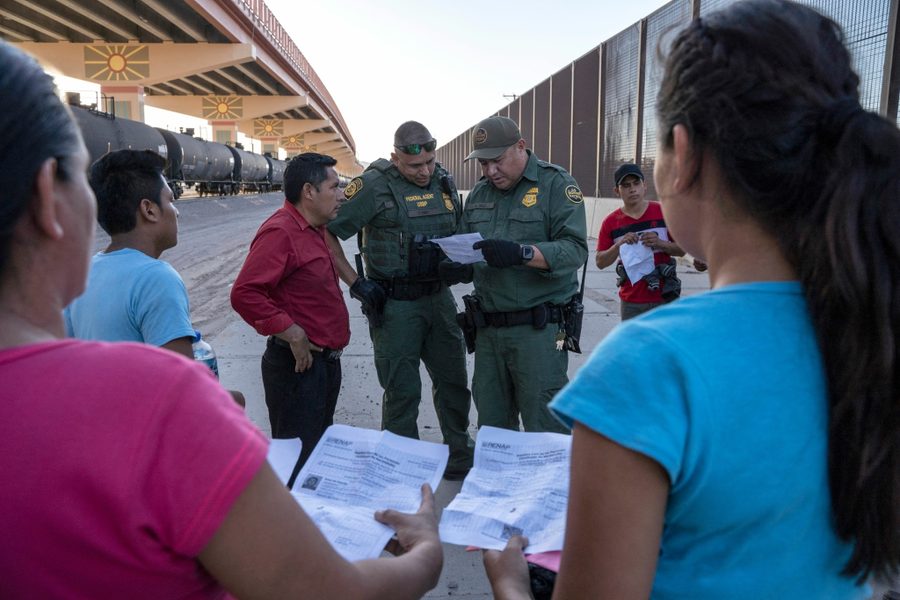Did This Supreme Court Just Issue a Progressive Ruling on Immigration? Sort Of.
The MPP ruling will bring immediate relief for migrants stuck in Mexico, but doesn’t signal anything humane about the court.
Adrian Rennix

With the barrage of bad decisions coming out of the Supreme Court lately — overturning Roe v. Wade, gutting the EPA, stripping municipalities of the ability to legislate reasonable gun control measures — it’s understandable that the Supreme Court’s last decision of this term has been somewhat lost in the news shuffle. In a 5-4 decision, the Supreme Court upheld the Biden administration’s termination of the Remain in Mexico policy, a border immigration program initiated under the Trump administration.
Officially known as the “MPP” or “Migrant Protection Protocols” — as the program was dubbed by Department of Homeland Security bureaucrats, in a little flourish of sadistic irony — the Remain in Mexico policy was instituted under the Trump administration to deter asylum-seekers from seeking protection at the southern border. Under Remain in Mexico, asylum-seekers who would ordinarily have been placed in immigration court proceedings inside the United States were instead forced to stay on the Mexican side of the border. Between the multiple court dates of their months-long asylum adjudication process, these asylum-seekers (including families with small children) were left stranded in Mexican border towns with very high murder rates. An organized crime industry quickly sprang up around kidnapping migrants en route to their hearings at ports of entry. These abductions involve death threats, forced confinement, and ransom demands (at minimum), and violent beatings, sexual assault, or murder (at worst). In addition to the physical dangers of waiting in Mexico, asylum-seekers in this program have had virtually no access to counsel in their asylum proceedings, and have faced constant struggles to find basic necessities like food and shelter. The program was atrocious under Trump and did not materially improve under Biden: Not only has violence in border areas continued, but even fewer migrants—less than 1% — were able to locate attorneys in the Biden-era iteration of the Remain in Mexico program.
Given this background, the Supreme Court’s decision to allow the Biden administration to end this program is, broadly speaking, a “good” outcome. Biden at first suspended, and then attempted to fully terminate, the Remain in Mexico program in 2021, but several conservative states sued to prevent the administration from doing so, and obtained an injunction that ordered the Biden administration to re-implement Remain in Mexico “in good faith” until the Supreme Court case was resolved. To secure this injunction, the states argued that they would face “irreparable harm” if Remain in Mexico were discontinued, because the state funds emergency rooms and public school systems that migrants and their children might utilize. These ludicrous justifications have become boilerplate “irreparable harms” cited by conservative states in a litany of similar suits intended to impede immigration enforcement policies that are anything short of maximally punitive toward asylum-seekers and other migrants.
In the Remain in Mexico case, the Supreme Court held against the states’ claim that the Biden administration was not allowed to end the program, finding that the Biden administration had terminated the program in a procedurally valid manner and that the termination was within its prerogative to manage immigration enforcement and foreign policy relations. This outcome is good in the short term: Remain in Mexico is now, in theory, over (although as of this writing, it hasn’t yet halted anywhere on the ground).
But it’s also important to understand why a majority-conservative Supreme Court made a decision that seems facially “pro-immigrant.” Firstly, the legal questions involved in this lawsuit didn’t pertain to whether the Remain in Mexico program was, in and of itself, either lawful or humane. The Supreme Court’s decision took it as a given that the federal executive does have the power to implement the Remain in Mexico program, no matter how many migrants suffer and die as a result. The only operative question is whether the federal government is obligated to have such a program if doesn’t wish to. The Supreme Court found that it is not, on the grounds that programs like Remain in Mexico are an option available to the government to handle border administration, but are not mandatory. The Supreme Court found that the Biden administration had adequately explained why the program no longer suited the government’s operational needs and foreign policy priorities. In short, this is fundamentally a ruling that retrenches the executive’s right to do whatever it thinks best on immigration—not a decision that strengthens immigrants’ rights to challenge the government when it treats them brutally and violates their rights.
Other recent Supreme Court decisions, in fact, have clearly tended to erode migrants’ ability to demand humane treatment from the government in any arena. The Supreme Court has limited immigrants’ ability to challenge the legality of their prolonged detention in a variety of contexts. It’s declared that higher courts lack jurisdiction to intervene even when the government orders someone’s deportation based on facts that are clearly, provably incorrect. It’s all but eliminated any person’s ability to sue federal immigration agents who assault them or their family’s ability to sue federal immigration agents who kill them. Another recent Supreme Court decision, also cited in the Remain in Mexico case, has found that lower courts henceforth can’t issue injunctions to restrain the federal government’s action in most cases where the government is accused of violating immigration law; from now on, only the Supreme Court can issue such injunctions. In the same decision, the Supreme Court also forbade detained migrants from bringing class-action lawsuits, a procedure that would normally allow a group of similarly-situated immigrants to seek a common remedy. This means that immigrants facing unlawful government action have no option but to file separate, individual suits. As Justice Sotomayor pointed out in her dissent:
Noncitizens subjected to removal proceedings are disproportionately unlikely to be familiar with the U. S. legal system or fluent in the English language. Even so, these individuals must navigate the Nation’s labyrinthine immigration laws without entitlement to appointed counsel or legal support. If they are detained, like respondents here, they face particularly daunting hurdles. On average, immigration detention facilities are located significantly farther away from detained individuals’ communities and court proceedings than criminal jails, making it extraordinarily difficult to secure legal representation. … In a great many cases, the inevitable consequence of barring classwide injunctive relief will be that those violations will go unremedied, except as to the few fortunate enough to afford competent collateral counsel or to secure vigorous pro bono representation. The burdens will fall on those least able to vindicate their rights.
Ultimately, the Supreme Court, and our court system generally, is not protective of immigrants’ rights, and has been busily stripping immigrants of most of the legal tools they would use to enforce their extremely limited rights to bodily safety and legal fairness. It’s worth celebrating that conservative states have apparently lost their battle to declare Remain in Mexico as the law of the land indefinitely — but there’s absolutely nothing to prevent this or any future administration from reviving Remain in Mexico, provided that they can provide some cursory justification for why it would benefit U.S. interests. Immigrants themselves barely even figure into these legal fights between the federal executive and state government, except as data points. In a legal system that already treats most ordinary people as expendable, noncitizens barely even qualify as people.
Adrian Rennix is an immigration attorney who works with detained asylum seekers in South Texas. The views expressed here are their own and not on behalf of any organization.






